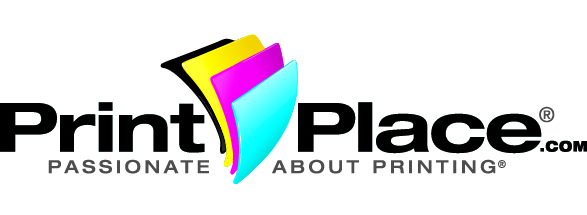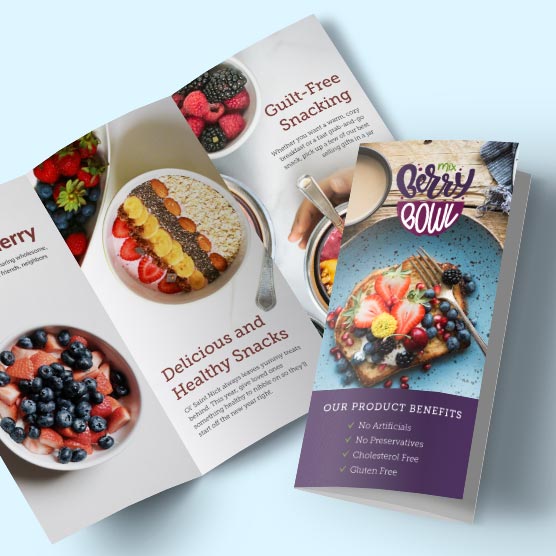Trifold vs. Z-Fold vs. Gate Fold: Which Brochure Should You Use?
Table of Contents
When printing brochures, it’s not just about the design; you also have to think about how it’s folded and presented. Whether it’s for promotions, guiding guests, or launching a new product, a brochure’s fold styles can make a difference in shaping your customer’s reading experience. But how do you know which one you should use? In this guide, PrintPlace compares three popular fold styles to help you decide on the best option.
What is a Trifold Brochure?
The trifold is a classic brochure fold where the 8.5” x 11” sheet is folded inward one at a time, overlapping the middle like a standard letter. This type of fold creates three equal sections on each side, and six panels total.
Pros
- Portable, fits in pockets easily
- Classic and familiar
- Affordable
Cons
- Smaller panels mean limited design space
- Can feel generic if not designed creatively
- Not ideal for high-end brandin
What is a Z-Fold Brochure?
The z-fold is a more modern brochure fold compared to the trifold. The sheet is divided into three panels and is folded in a zig-zag pattern like an accordion, making the brochure easier to open and scan in sequence.
Pros
- Great for storytelling and instructions
- Has a modern look
- Easy to follow
- Flexible layout
- Smooth unfolding
- Ideal for graphics and images
Cons
- Not as compact as the trifold
- May appear informal
- Design and content can look cluttered if not organized
What is a Gate Fold Brochure?
The gate fold features two side panels that open outward like double doors. This fold style allows for a more dramatic reveal and has a larger center panel inside.
Pros
- Premium feel
- Eye-catching with its high-impact reveal
- Suitable for showcasing visuals
Cons
- Can cost more to print
- Not suitable for heavy text
- Can seem too bulky and less practical
Side-by-Side Comparison: Trifold vs. Z-Fold vs. Gate Fold
Looking for a quick guide? Here’s a side-by-side comparison of each fold style to help you make an easier decision.
| Feature | Trifold | Z-Fold | Gate Fold |
|---|---|---|---|
| Panels | 6 | 6 | 4 (plus large inner spread) |
| Ease of Use | Very intuitive | Easy to scan, flip back and forth | Simple but less common |
| Best For | General marketing, menus, service info | Maps, event guides, presentations | Luxury products, event invites |
| Design Style | Traditional, familiar | Modern, versatile | Bold, dramatic, premium |
| Cost | Budget-friendly | Budget-friendly | Higher due to specialty printing |
| Reader Experience | Step-by-step flow | Free-flow, easy to navigate | Big reveal, makes a statement |
- Panels – Both the trifold and z-fold have six panels, making it easy to organize the content into digestible sections. Meanwhile, the gate fold features four panels and has a large center panel perfect for bold images and text.
- Ease of Use – The trifold is the easiest to use for readers because people are familiar with how to unfold it. On the other hand, the z-fold’s zig-zag design allows for a smooth flow and quick scanning without the need for the brochure to be fully opened. Lastly, the gate fold is very straightforward, but because it’s less common than the trifold and the z-fold, scanning it feels fresh and engaging.
- Best For – The trifold is ideal for information-heavy content where organization and clarity are needed the most, like menus, service sheets, and everyday brochures. The z-fold is recommended for brochures with content that needs easy navigation, such as maps, informational guides, product showcases, or event schedules, which are something that people need to reference several times. Meanwhile, the gate fold is designed for brochures with high-impact content meant to impress, like invitations, portfolios, and high-end brand presentations.
- Design Style – The trifold’s design feels more traditional and familiar, making it suitable for various businesses. The z-fold feels more dynamic and allows designers to showcase visuals across panels, while the gate fold has more dramatic flair with the way the content is revealed.
- Cost – Both the trifold and z-fold are generally more affordable since they use standard paper sizes and folds. On the other hand, the gate fold can be more expensive since it sometimes requires specialty folding and thicker material to support the brochure’s structure.
- Reader Experience – The trifold feels like you’re reading a booklet; everything is organized, step by step. The z-fold is more interactive and allows readers to skim or unfold the brochure completely. As for the gate fold, its design feels like you’re unboxing a gift
How to Choose the Right Fold Style
If you’re still unsure of what fold style to go for, consider these factors when choosing one:
Your Content Amount and Storytelling Needs
- Does your brochure have lots of information? Choose a trifold.
- Does your brochure have plenty of images or is it map-based? Z-fold is your best option
- Does it have minimal text, but has big visuals, and you want to add an element of surprise? Gate fold is the fold style for you.
Your Audience
- Promoting for everyday customers? Choose a trifold.
- Tourists, event-goers, students, or travelers? Z-fold is the ideal choice for quick scanning.
- If your readers are VIP clients, donors, or luxury shoppers, the gate fold will capture their attention.
Your Budget
- If you’re on a tight budget, choose folds that are more budget-friendly like the trifold and z-fold.
- If you want to go all out for impact, the gate fold is the fold style you need.
Design and Printing Tips for Any Fold
Once you’ve decided on a fold style, don’t forget to make your brochures look polished and professional. Here are some tips to keep in mind:
-
- Keep your design simple but impactful. Avoid cluttered designs or heavy blocks of text. Break your content into digestible sections by using headers, bullet points, or images to guide readers.
- Use flow to your advantage. Design your panels the way you want the brochure to unfold.
- Don’t forget about the bleed, safe margins, and panel alignment. Ensure that background colors or images go past the trim to avoid white edges and double-check if all text and design elements are aligned and kept within the safe margins.
- Invest in professional printing. Choose a trusted print provider to make sure that you get accurate and premium-quality paper stock and prints every time.
- Use brochure templates. If you want to save time or don’t have any design experience, use design templates to create your brochures. These templates will help ensure correct sizing, bleeds, and fold marks and prevent any alignment issues.
Key Takeaways
- The trifold and z-fold are more affordable compared to the gate fold.
- The z-fold is the best option for big visuals and storytelling.
- When choosing a fold style, consider factors like your content, audience, and budget.
- The gate fold is the only fold style with four panels, but it’s also the one that has a “wow” factor when unfolding it.
Each fold style has its own purpose, function, strengths, and weaknesses — and the right one depends on your goals and what you want readers to experience. When choosing between trifold, z-fold, or gate fold, remember to pair it with thoughtful design and quality printing. This way, you can create a brochure that does more than just being a handout. Ready to print custom brochures? Order from PrintPlace today. We’re passionate about printing, and we’re proud to offer friendly, professional online printing services.
Related Articles
Folding Ideas: A Guide to Trifold Brochure Layouts
Brochure Tips for the Small Business Owner
Evolution of Brochure Design

PrintPlace’s mission is to provide customers with unparalleled printing services through the knowledge and expertise of its employees.


